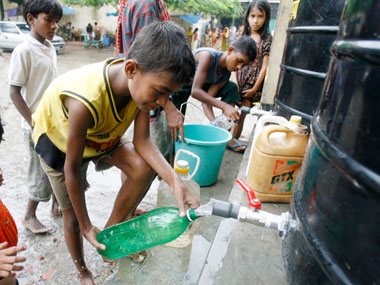A study based on data collected from a NASA satellite has revealed that the underground aquifers of the world, a very important source of fresh water for people, are being depleted at an alarming rate. [caption id=“attachment_2301192” align=“alignleft” width=“380”] Representational image. Reuters[/caption] According to data gathered from NASA’s Gravity Recovery and Climate Experiment (GRACE) satellite, twenty-one of the world’s 37 largest aquifers have gone beyond their sustainability tipping point, which means that the amount of water removed from these aquifers over the decade-long study, reported
The Washington Post
. One of the most alarming findings of this study was that the aquifer in the Indus basin region in India and Pakistan was the world’s second-most stressed aquifer. A stressed aquifer is one suffering from rapid depletion with almost no signs of recovery. To get some perspective on how serious the problem is: the only aquifer that was more stressed than the Indus basin was the Arabian aquifer, a water sourced used by over 60 million people. The report also said that underground aquifers account for 35 percent of the water used by the world. The consequences of aquifers drying up slowly could severely affect India in the future, where alternatives for water sources are limited and shortages might lead to instability in the region. Another result of unrestricted usage of water from aquifers is that since water from aquifers is moved to the surface, it would account for a 25 percent rise in sea levels before 2050, according to a 2012 study, reported
The Atlantic
. This would make relocated groundwater the third-most significant cause for rise in sea level this century. The data on the basis of which these conclusions were drawn was collected from the GRACE satellite, which was launched in 2002. It measures water the under the ground by analysing the variation in gravitational tug across the planet. The study based on the data collected was published in the Water Resources Research journal. You can read the entire study
here
.
Representational image. Reuters[/caption] According to data gathered from NASA’s Gravity Recovery and Climate Experiment (GRACE) satellite, twenty-one of the world’s 37 largest aquifers have gone beyond their sustainability tipping point, which means that the amount of water removed from these aquifers over the decade-long study, reported
The Washington Post
. One of the most alarming findings of this study was that the aquifer in the Indus basin region in India and Pakistan was the world’s second-most stressed aquifer. A stressed aquifer is one suffering from rapid depletion with almost no signs of recovery. To get some perspective on how serious the problem is: the only aquifer that was more stressed than the Indus basin was the Arabian aquifer, a water sourced used by over 60 million people. The report also said that underground aquifers account for 35 percent of the water used by the world. The consequences of aquifers drying up slowly could severely affect India in the future, where alternatives for water sources are limited and shortages might lead to instability in the region. Another result of unrestricted usage of water from aquifers is that since water from aquifers is moved to the surface, it would account for a 25 percent rise in sea levels before 2050, according to a 2012 study, reported
The Atlantic
. This would make relocated groundwater the third-most significant cause for rise in sea level this century. The data on the basis of which these conclusions were drawn was collected from the GRACE satellite, which was launched in 2002. It measures water the under the ground by analysing the variation in gravitational tug across the planet. The study based on the data collected was published in the Water Resources Research journal. You can read the entire study
here
.
NASA study reveals world's running out of groundwater, and India's particularly at risk
FP Staff
• June 18, 2015, 14:13:38 IST
A study based on data collected from a NASA satellite has revealed that water from underground aquifers of the world are being depleted at an alarming rate.
Advertisement
)
End of Article